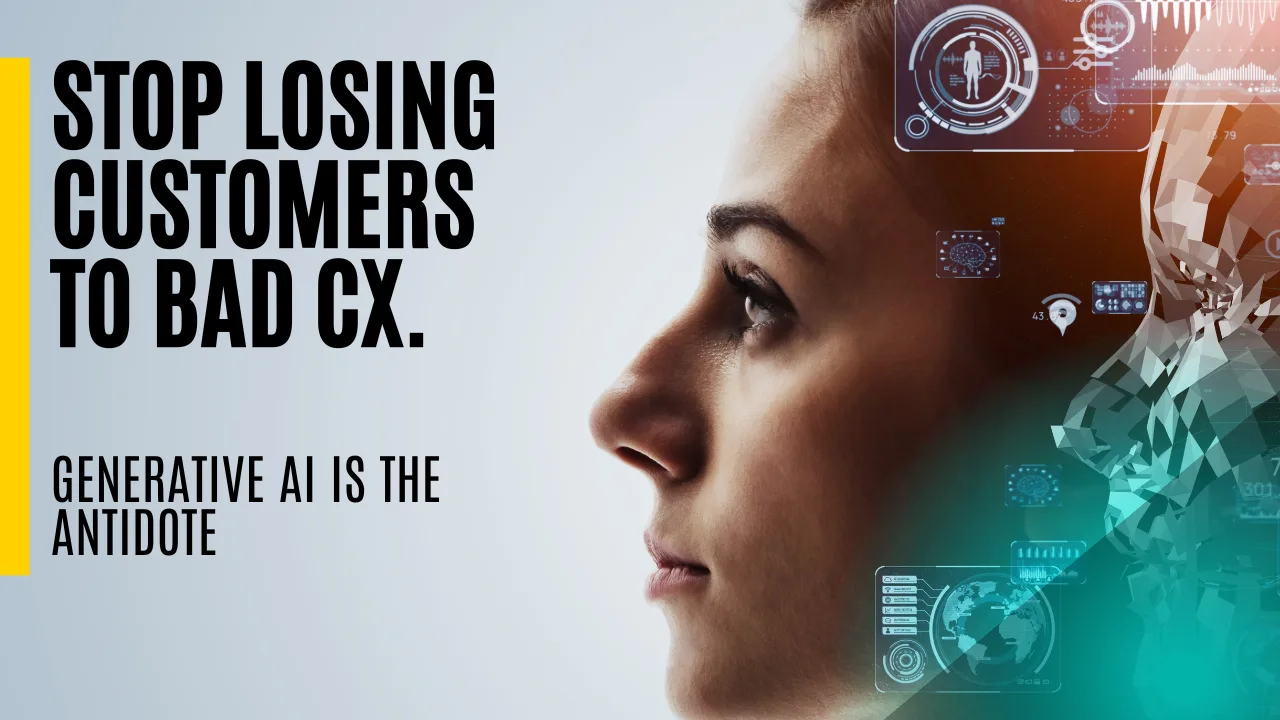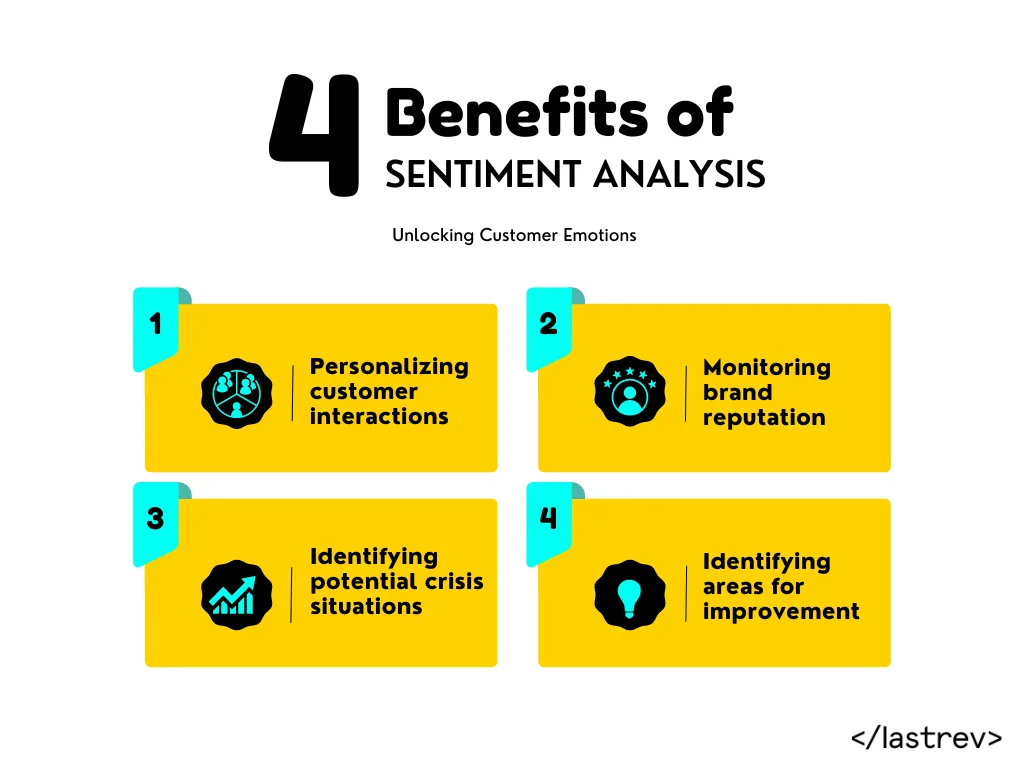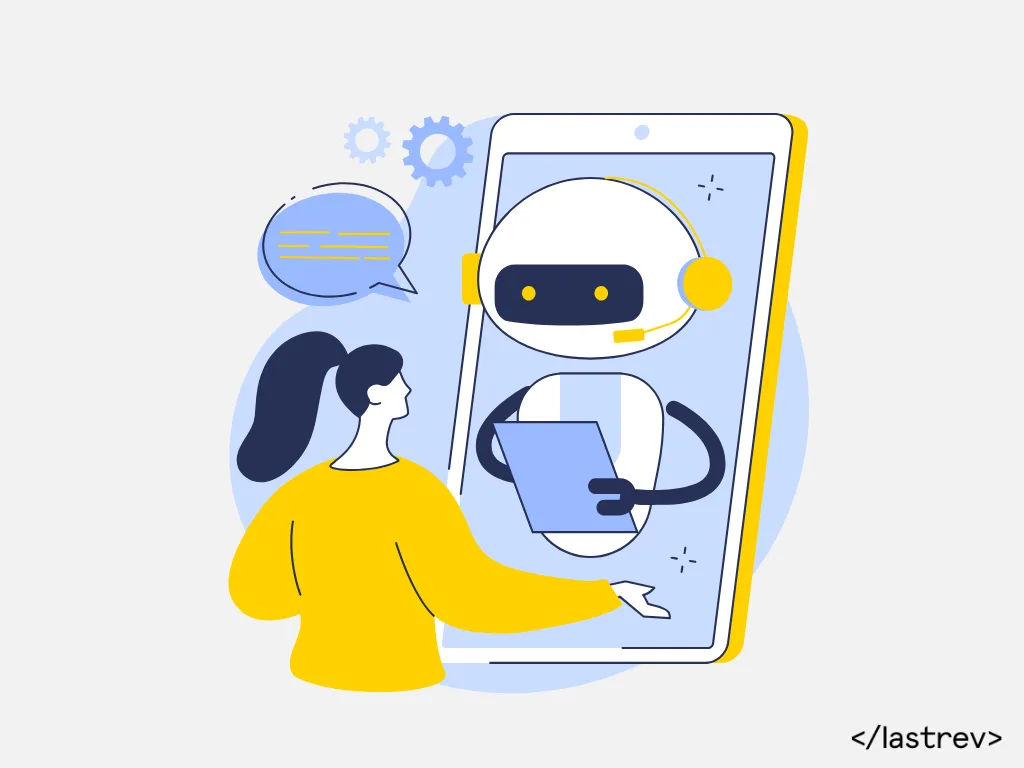From Data to Dialogue: Leveraging Generative AI for Enhancing Customer Experience
08/19/2024
Brad Taylor

Customer Experience (CX) has evolved from a mere buzzword to a critical business differentiator. In today's hyper-competitive landscape, organizations that prioritize exceptional CX are more likely to retain customers, drive loyalty, and ultimately, boost their bottom line. Traditionally, AI has played a role in enhancing CX through tools like chatbots and sentiment analysis. However, the advent of generative AI marks a pivotal moment, promising to revolutionize the way businesses interact with their customers.
In this blog post, we'll delve deep into the world of generative AI, exploring its capabilities and potential to transform CX. We'll examine how this groundbreaking technology can be harnessed to create personalized experiences, improve customer interactions, and gain invaluable insights.
Understanding Customer Experience (CX)
Customer Experience (CX) encompasses every interaction a customer has with a brand, from initial awareness to post-purchase support. It's the sum total of all touchpoints, both online and offline, that shape a customer's perception of a company.
In today's fiercely competitive market, delivering exceptional CX is no longer a luxury but a necessity. Satisfied customers are more likely to become loyal advocates, make repeat purchases, and refer friends and family. Conversely, negative experiences can lead to customer churn, negative word-of-mouth, and irreparable damage to a brand's reputation.
To measure CX effectively, businesses rely on a variety of metrics, including:
Customer Satisfaction (CSAT): Evaluates overall satisfaction with a product or service.
Customer Effort Score (CES): Measures the ease of interacting with a company.
Net Promoter Score (NPS): Predicts customer loyalty and advocacy.
Customer Lifetime Value (CLTV): Quantifies the long-term value of a customer.
By understanding these metrics and focusing on continuous improvement, organizations can deliver CX that exceeds customer expectations.
Traditional Challenges in Customer Experience (CX) and the AI Transformation
Customer Experience (CX) has evolved from a mere concept to a critical business function. However, it has been fraught with challenges that have hindered businesses from delivering exceptional customer experiences. The advent of Artificial Intelligence (AI) is reshaping this landscape, offering innovative solutions to age-old problems.
Pre-AI Era: A CX Landscape Marked by Challenges
Before the widespread adoption of AI, businesses grappled with several CX hurdles:
Inconsistent Experiences: Customers often encountered varying levels of service across different channels, leading to frustration and dissatisfaction.
Slow Response Times: Resolving customer issues or inquiries frequently took excessive time, eroding customer loyalty.
Difficulty in Personalization: Delivering tailored experiences to individual customers was a complex and resource-intensive task.
Data Silos: Information about customers was fragmented across different departments, hindering a holistic view of customer needs.
Measuring CX: Quantifying the impact of CX initiatives was challenging due to a lack of robust metrics and analytics.

The AI Transformation: A New Era of CX
The integration of AI into CX strategies has been a game-changer, addressing many of these traditional challenges.
Early Adoption (2010-2015): The Foundation is Laid
Basic Chatbots: Initial AI applications focused on simple chatbots for basic customer inquiries, improving response times and freeing up human agents.
Data Analytics: AI-powered analytics tools began to provide insights into customer behavior, helping businesses identify trends and patterns.
Maturation Phase (2015-2020): AI Becomes a CX Catalyst
Advanced Analytics: AI-driven predictive analytics enabled businesses to anticipate customer needs and preferences, leading to proactive service delivery.
Personalized Experiences: AI-powered recommendation systems delivered tailored product suggestions and content, enhancing customer satisfaction.
Sentiment Analysis: AI tools started to analyze customer feedback, allowing businesses to identify areas for improvement and address negative sentiment promptly.
The AI-Driven CX Revolution (2020-Present): Redefining Customer Interactions
Hyper-Personalization: AI-powered algorithms create highly customized experiences based on individual customer preferences and behavior.
Intelligent Virtual Assistants: Sophisticated AI-powered virtual assistants provide comprehensive support, answering complex queries and resolving issues efficiently.
Augmented Customer Service: AI augments human agents' capabilities, enabling them to focus on high-value interactions and improve problem-solving.
Predictive CX: AI forecasts customer needs and behaviors, allowing businesses to deliver proactive and anticipatory service.
Omnichannel Consistency: AI ensures seamless customer experiences across all touchpoints, delivering a unified brand image.

AI has been instrumental in addressing the traditional challenges of CX. By enabling personalization, improving efficiency, and delivering exceptional customer experiences, AI is reshaping the CX landscape and driving business success. As AI technology continues to advance, we can expect even more groundbreaking innovations that will redefine the customer journey.
Traditional AI in CX: Building the Foundation
Artificial Intelligence has been making strides in enhancing customer experiences for several years. While it may not have the same level of sophistication as generative AI, traditional AI has proven to be a valuable tool in various CX applications.
Sentiment Analysis: Unlocking Customer Emotions
Sentiment analysis is a cornerstone of traditional AI in CX. It involves the automated identification and extraction of subjective information from text data to understand customer sentiment. By analyzing customer feedback from social media, surveys, emails, and reviews, businesses can gain valuable insights into customer emotions, opinions, and attitudes towards their products or services.
Key benefits of sentiment analysis include:
Identifying areas for improvement
Monitoring brand reputation
Identifying potential crisis situations
Personalizing customer interactions

Popular sentiment analysis tools: IBM Watson, Lexalytics
IBM Watson
IBM Watson is a comprehensive AI platform that offers a suite of tools for various applications, including sentiment analysis. It excels in processing vast amounts of unstructured data, such as social media posts, customer reviews, and survey responses. Watson's natural language processing capabilities allow it to accurately identify and extract sentiments, enabling businesses to understand customer opinions and preferences.
Lexalytics
Lexalytics specializes in advanced text analytics and sentiment analysis. It is known for its ability to handle complex language nuances and industry-specific jargon. Lexalytics provides insights into customer sentiment, brand perception, and competitive intelligence. It offers a flexible platform that can be customized to meet specific business needs.
Both IBM Watson and Lexalytics are powerful tools for organizations seeking to understand customer sentiment and leverage insights for improved decision-making. The choice between the two often depends on specific requirements, such as data volume, industry focus, and desired level of customization.
Mass Survey Analysis: Deriving Insights from Customer Feedback
Traditional AI also plays a crucial role in processing and analyzing large volumes of survey data. Tools like SurveyMonkey and Qualtrics leverage AI to automate data entry, identify trends, and generate reports. This enables businesses to quickly understand customer preferences, pain points, and satisfaction levels.
Key benefits of mass survey analysis include:
Identifying customer segments
Measuring customer satisfaction
Tracking performance over time
Identifying areas for improvement

Case Studies: Traditional AI in Action
To illustrate the impact of traditional AI on CX, let's examine a few real-world examples:
Case Study: Sentiment Analysis in the Airline Industry
Airlines have been early adopters of sentiment analysis. By monitoring social media conversations, airlines can quickly identify customer issues, such as flight delays, cancellations, or poor service. This enables them to respond promptly, mitigate negative sentiment, and protect their brand reputation.
For instance, during a major snowstorm, an airline could use sentiment analysis to identify tweets expressing frustration about flight cancellations. By categorizing these tweets based on sentiment, the airline can prioritize customer support efforts, offer rebooking options, and provide timely updates, ultimately improving customer satisfaction.
Case Study: Mass Survey Analysis in Retail
Retailers often conduct customer satisfaction surveys to understand shopping preferences, identify areas for improvement, and measure the impact of marketing campaigns. By leveraging AI to analyze survey data, retailers can uncover valuable insights into customer behavior.
For example, a clothing retailer might use survey data to identify which product categories are most popular, which marketing channels are most effective, and which stores offer the best customer experience. This information can be used to optimize product offerings, target marketing efforts, and improve store operations.
These are just a few examples of how traditional AI has been used to enhance CX. While these tools have proven effective, they have limitations. The next section will explore how generative AI can overcome these limitations and revolutionize customer experiences.
The Emergence of Generative AI: A New Frontier in CX
While traditional AI has been a valuable asset in CX, it has limitations. Generative AI, on the other hand, represents a quantum leap forward. This technology is capable of generating new content, such as text, images, and even music, based on the data it has been trained on.
What is Generative AI?
Generative AI is a subset of artificial intelligence that focuses on creating new content rather than analyzing existing data. It employs complex algorithms and vast amounts of data to generate human-like text, images, or other creative outputs.
Key characteristics of generative AI include:
Creativity: Ability to generate novel and original content.
Adaptability: Capacity to learn and adapt to new information.
Versatility: Potential to be applied across various industries and applications.
OpenAI's Generative Models
OpenAI has been at the forefront of generative AI research and development. Their models, such as GPT-4 and DALL-E, have demonstrated remarkable capabilities:
GPT-4: This large language model excels at generating human-quality text, translating languages, writing different kinds of creative content, and answering your questions in an informative way.
DALL-E: This model can create images from text descriptions. For example, if you ask it to generate an image of a cat playing the piano, it can produce various images of that scene.
These models, and others like them, are driving innovation and expanding the possibilities of generative AI.
Key Differences Between Traditional AI and Generative AI
Feature | Traditional AI | Generative AI |
Focus | Analysis and prediction | Creation and generation |
Output | Insights, recommendations | New content, ideas |
Applications | Sentiment analysis, chatbots, recommendation systems | Content creation, design, product development |

Generative AI has the potential to revolutionize CX by offering unprecedented levels of personalization, engagement, and efficiency.
Advantages of Generative AI in CX
Generative AI has the potential to transform customer experiences in several ways:
Enhanced Personalization
Generative AI can create highly personalized experiences by analyzing vast amounts of customer data to generate tailored content, product recommendations, and marketing messages.
Dynamic content generation: Netflix uses generative AI to create personalized movie and TV show recommendations based on viewing history, ratings, and genre preferences. Additionally, the platform generates unique artwork and descriptions for each user, enhancing the overall viewing experience.
Hyper-personalized recommendations: Amazon's recommendation engine leverages generative AI to suggest products based on purchase history, browsing behavior, and even items viewed by similar customers. This level of personalization drives sales and increases customer satisfaction.
Customized marketing campaigns: Coca-Cola employed generative AI to create personalized video ads based on individual customer preferences and demographics. The campaign resulted in higher engagement rates and improved conversion rates.

Improved Customer Interactions
Generative AI can revolutionize how businesses interact with customers by enabling more natural and engaging conversations.
Intelligent chatbots: Many companies, such as Sephora and Nike, have implemented AI-powered chatbots that can provide product information, answer customer queries, and even assist with purchases in a conversational manner.
Virtual assistants: Apple's Siri, Amazon's Alexa, and Google Assistant are examples of generative AI-driven virtual assistants that can perform tasks, provide information, and create a more personalized user experience.
Real-time customer support: Companies like Zendesk are incorporating generative AI into their customer support platforms to enable agents to provide faster, more accurate, and personalized responses to customer inquiries.

Predictive Insights and Recommendations
By analyzing customer data, generative AI can uncover valuable insights and predict customer behavior.
Predictive analytics: Retailers like Target utilize generative AI to forecast product demand, optimize inventory levels, and personalize promotions based on customer purchasing patterns.
Proactive customer support: Airlines like Delta use AI to predict flight delays and proactively notify customers, offering alternative travel options or compensation.
Upselling and cross-selling opportunities: Companies like Amazon recommend complementary products based on a customer's purchase history, increasing average order value.
By leveraging these capabilities, businesses can create more engaging, relevant, and satisfying customer experiences.
Case Studies: Generative AI in Action
Let's explore how generative AI is being applied to enhance customer experiences across various industries.
Retail Industry: Sephora's Virtual Try-On
Sephora, a leading beauty retailer, has leveraged generative AI to create a revolutionary virtual try-on experience. Customers can virtually apply makeup products using augmented reality, powered by generative AI algorithms that accurately simulate product application. This innovative approach enhances the shopping experience, reduces returns, and drives sales.
Healthcare Sector: IBM Watson Health
IBM Watson Health is utilizing generative AI to improve patient care and support. By analyzing vast amounts of medical data, AI models can generate personalized treatment plans, predict disease outbreaks, and accelerate drug discovery. Additionally, generative AI-powered chatbots can provide patients with accurate and timely information about their health conditions.
Finance Sector: JP Morgan Chase
JP Morgan Chase is employing generative AI to enhance customer service and fraud detection. AI-powered chatbots can handle routine customer inquiries, freeing up human agents to focus on complex issues. Furthermore, generative AI algorithms can analyze transaction data to identify patterns indicative of fraudulent activity, protecting customers and the bank from financial losses.
These are just a few examples of how generative AI is transforming industries. As the technology continues to evolve, we can expect to see even more innovative applications emerge.
Challenges and Considerations in Implementing Generative AI
While generative AI holds immense promise for enhancing customer experiences, it also presents a number of challenges and considerations that businesses must address.
Ethical Concerns
Bias: Generative AI models are trained on vast amounts of data, which can inadvertently introduce biases into their outputs. This can lead to discriminatory or unfair outcomes.
Privacy: Handling and processing sensitive customer data raises privacy concerns. Organizations must implement robust data protection measures to safeguard customer information.
Misinformation: Generative AI can be used to create deepfakes and spread misinformation, damaging brand reputation and public trust.
Integration Challenges
Existing Systems: Integrating generative AI with existing customer relationship management (CRM) and other enterprise systems can be complex and time-consuming.
Data Quality: The quality of the data used to train generative AI models is crucial. Poor data quality can lead to inaccurate and unreliable outputs.
Skill Gap: Many organizations lack the necessary expertise to develop and deploy generative AI applications.
In addition, detailed challenges of integrating generative AI with current CX tools include:
Challenges | Description |
Data Compatibility | Generative AI models often require specific data formats that may not be compatible with existing CRM systems or other customer data repositories. Extensive data transformation or restructuring might be necessary. |
System Integration Complexity | Integrating generative AI with existing CX tools can be a complex technical challenge. APIs (Application Programming Interfaces) may need to be developed to facilitate communication between different systems. |
Security Concerns | Integrating AI introduces new security considerations. Businesses need to ensure that sensitive customer data is protected throughout the integration process. |
Workflow Disruption | Implementing generative AI may disrupt existing workflows and require changes in how customer service representatives or marketing teams operate. Training and support are crucial for a smooth transition. |
Vendor Lock-in | Choosing a specific generative AI vendor can lead to vendor lock-in, making it difficult to switch to another provider in the future. |
By carefully considering these challenges and developing a comprehensive integration strategy, businesses can successfully incorporate generative AI into their CX toolset and unlock its full potential.
Other Considerations
Cost: Implementing generative AI can be expensive, requiring significant investments in technology, infrastructure, and talent.
Explainability: Understanding how generative AI models arrive at their decisions can be challenging, making it difficult to explain their outputs to customers and regulators.
Addressing these challenges requires a careful and strategic approach. By understanding the potential risks and developing appropriate mitigation strategies, organizations can harness the power of generative AI while minimizing negative impacts.
The Future of AI and CX: A Glimpse into Tomorrow
The landscape of AI, particularly generative AI, is evolving rapidly. As we look ahead, several trends will shape the future of customer experience:
Evolving Capabilities of Generative AI
Multimodal AI: The integration of text, image, and voice capabilities will create more immersive and engaging customer experiences.
Real-time adaptation: Generative AI models will become increasingly adept at learning and adapting to customer preferences in real-time.
Hyper-personalization: The ability to create truly individualized experiences will become the norm.
Predictions for the Future of AI in CX
AI-driven empathy: Generative AI will be able to understand and respond to customer emotions with greater nuance, fostering deeper connections.
Autonomous customer service: AI-powered agents will handle a growing percentage of customer inquiries, freeing up human agents for more complex issues.
Predictive CX: By anticipating customer needs and desires, businesses will be able to deliver proactive and personalized experiences.
Future Trends in AI and CX
The intersection of AI and CX is a dynamic landscape, continually evolving with new possibilities. Several key trends will shape the future of this relationship:
Ethical AI
Beyond fairness, unbiasedness, and transparency, ethical AI in CX will also require:
Accountability: Establishing clear responsibility for AI decisions and their outcomes.
Explainability: Developing AI models that can articulate their reasoning processes to users.
Human oversight: Maintaining human control and intervention in AI systems to prevent unintended consequences.
Privacy preservation: Ensuring that AI systems respect individual privacy rights while utilizing data effectively.
AI for Good
Generative AI can be a powerful force for positive change:
Social impact: Addressing social issues like poverty, inequality, and healthcare access through AI-driven solutions.
Environmental sustainability: Optimizing resource consumption, reducing waste, and promoting sustainable practices with AI.
Accessibility: Making technology and services accessible to people with disabilities through AI-powered innovations.
AI and Human Collaboration
The synergy between humans and AI will be essential for optimal CX:
Augmented intelligence: Empowering human agents with AI-driven insights and recommendations to enhance their performance.
Emotional intelligence: Combining AI's data processing capabilities with human empathy to create deeply connected customer experiences.
Shared responsibility: Distributing tasks and decision-making between humans and AI based on their respective strengths.
Continuous learning: Fostering a culture of experimentation and adaptation as AI and human roles evolve.

Additional Trends
Hyper-personalization: Leveraging AI to create tailored experiences for individual customers, anticipating their needs and preferences.
Predictive CX: Using AI to forecast customer behavior and proactively address potential issues.
Omnichannel consistency: Ensuring seamless customer experiences across all touchpoints through AI-powered orchestration.
AI-driven design: Using AI to optimize user interfaces and create intuitive customer journeys.
By embracing these trends, businesses can harness the power of AI to deliver exceptional customer experiences while upholding ethical standards and contributing to a better future.
How Last Rev Can Help You with Generative AI Implementation in CX
In today’s competitive market, delivering exceptional customer experiences (CX) is crucial for business success. Generative AI offers transformative potential to enhance CX by providing personalized, efficient, and interactive customer interactions. Last Rev is here to help you harness this potential and revolutionize your customer service.
Why Choose Last Rev for Generative AI Implementation?
Expertise in AI Technology: Our team of AI experts has extensive experience in implementing generative AI solutions across various industries. We understand the nuances of AI technology and how to tailor it to meet your specific CX needs.
Customized Solutions: We don’t believe in one-size-fits-all. Last Rev works closely with your team to develop customized AI solutions that align with your business goals and customer expectations. Whether it’s enhancing customer support, personalizing marketing efforts, or automating routine tasks, we’ve got you covered.
Seamless Integration: Our solutions are designed to integrate seamlessly with your existing systems. We ensure a smooth transition and minimal disruption to your operations, allowing you to start reaping the benefits of generative AI quickly.
Continuous Support and Optimization: Last Rev provides ongoing support to ensure your AI solutions continue to perform optimally. We monitor performance, make necessary adjustments, and keep you updated with the latest advancements in AI technology.
Conclusion: The Future of CX is Generative
Generative AI marks a new era in customer experience. By offering unparalleled personalization, improving customer interactions, and providing valuable insights, this technology has the potential to revolutionize how businesses connect with their customers.
While challenges and considerations exist, the benefits of embracing generative AI far outweigh the risks. By investing in this technology and developing a strategic approach, organizations can create exceptional customer experiences that drive loyalty, advocacy, and business growth.
Next Steps
The future of CX is in generative AI. Don't be left behind. Start exploring the possibilities of this transformative technology today. Assess your organization's readiness, identify potential use cases, and begin building a roadmap for AI-powered CX.
Partner with Last Rev and take the first step towards a more personalized, efficient, and engaging customer journey.
By taking decisive action, your business can unlock the full potential of generative AI and achieve unprecedented levels of customer satisfaction.
Remember: The key to success lies in understanding your customers, leveraging data effectively, and continuously iterating on your AI strategies.
Schedule a consultation with Julie Basque and discover how our generative AI solutions can elevate your CX strategy. Let’s revolutionize your customer interactions together!
